The nilgai is diurnal (active mainly during the day). The animals band together in three distinct kinds of groups: one or two females with young calves, three to six adult and yearling females with calves, and all-male groups with two to 18 members. Typically tame, the nilgai may appear timid and cautious if harassed or alarmed; it flees up to 300 metres (980 ft)-or even 700 metres (2,300 ft), galloping away from the source of danger. Herbivores, nilgai prefer grasses and herbs, though they commonly eat woody plants in the dry tropical forests of India. Females become sexually mature by two years, while males do not become sexually active until four or five years old. The time of the year when mating takes place varies geographically, but a peak breeding season lasting three to four months can be observed at most places. Gestation lasts eight to nine months, following which a single calf (sometimes twins or even triplets) is born. As typical of several bovid species, nilgai calves stay hidden for the first few weeks of their lives. The lifespan of the nilgai is around ten years.
Nilgai prefer areas with short bushes and scattered trees in scrub forests and grassy plains. They are common in agricultural lands, but hardly occur in dense forest. Major populations occur in the Terai lowlands in the foothills of the Himalayas (northern India), but the antelope is sparsely found in Nepal and Pakistan. It was first thought to be extinct in Bangladesh but it was found there on 22 January 2019.[3] Nilgai were first introduced to Texas in the 1920s and the 1930s. As of 2008, the feral population in Texas is nearly 37,000. The nilgai is categorised as Least Concern by the IUCN. The nilgai has been associated with Indian culture since the Vedic period (1500–500 BC). Hindus revere the nilgai as sacred and associate it with the cow, the mother animal in Hinduism, through its name and loosely similar physical features. They were hunted in the Mughal era (16th to 19th centuries) and are depicted in numerous miniatures. Nilgai have been considered a pest in several north Indian states, as they ravage crop fields and cause considerable damage. In Bihar, authorities have classified the nilgai as vermin.
Etymology
The vernacular name "nilgai" /ˈnɪlˌɡaɪ/ comes from the fusion of the Hindi words nil ("blue") and gai ("cow"). The word was first recorded in use in 1882.[4] Alternative origins could be from the Persian gaw ("cow").[2] The nilgai has been referred to by a variety of names: neelghae,[2] nilgau, nilgo,[1] nylghau,[5] and nylghai,[6] constructions referring to other "blue" animals. They are also known as white-footed antelope.[2] During Mughal emperor Aurangzeb's reign (1658–1707) of India, the nilgai was known by the name nilghor ("nil" for "blue" and "ghor" for "horse").[7]Taxonomy
The scientific name of the nilgai is Boselaphus tragocamelus. The nilgai is the sole member of the genus Boselaphus and placed in the family Bovidae. The species was described and given its binomial name by the German zoologist Peter Simon Pallas in 1766.[8] He based his description on a 1745 account of a male nilgai by British physician James Parsons in the 43rd volume of Philosophical Transactions (now known as the Philosophical Transactions of the Royal Society).[9][10] The nilgai has one other relative in the tribe Boselaphini, the four-horned antelope (the sole member of Tetracerus).[11]The generic name Boselaphus comes from the combination of the Latin bos ("cow" or "ox") and the Greek elaphos ("deer").[12] The specific name tragocamelus comes from the join of the two Greek words tragos ("he-goat") and kamelos ("camel"). The binomial combination was first used by English zoologist Philip Sclater in 1883.[2] Boselaphus has often been misspelled as Buselaphus (first used by Ludwig Reichenbach in 1845 for the red hartebeest)[13] and Bosephalus (first used by Thomas Horsfield in 1851, when he mistook a nilgai specimen for a hartebeest in a museum catalogue of the East India Company).[2]
Evolution
A 1992 phylogenetic study of mitochondrial DNA sequences showed a strong possibility of a clade consisting of Boselaphini, Bovini and Tragelaphini. Bovini consists of the genera Bubalus, Bos, Pseudoryx (saola), Syncerus (African Buffalo), Bison and the extinct Pelorovis. Tragelaphini consists of two genera: Taurotragus (eland) and Tragelaphus. A closer relationship between Boselaphini and Tragelaphini was predicted,[14] and seconded by a similar study in 1999.[15]
| |||||||||||||
Remains of the nilgai dating back to the Pleistocene have been discovered from the Kurnool caves in southern India.[26] Evidence suggests that they were hunted by humans during the Mesolithic period (5,000 to 8,000 years ago).[27][28]
Description
Close view of a male nilgai showing the facial markings, throat patch, beard and short horns.
The nilgai is the largest antelope in Asia.[7][29] It stands 1–1.5 metres (3.3–4.9 ft) at the shoulder;[30] the head-and-body length is typically between 1.7–2.1 metres (5.6–6.9 ft).[7] Males weigh 109–288 kilograms (240–635 lb); the maximum weight recorded is 308 kilograms (679 lb). Females are lighter, weighing 100–213 kilograms (220–470 lb).[30] Sexual dimorphism is prominent; the males are larger than females and differ in colouration.[2]
A sturdy thin-legged antelope, the nilgai is characterised by a sloping back, a deep neck with a white patch on the throat, a short mane of hair behind and along the back ending behind the shoulder, and around two white spots each on its face, ears, cheeks, lips and chin.[7] The ears, tipped with black, are 15–18 centimetres (5.9–7.1 in) long.[2] A column of coarse hair, known as the "pendant" and around 13 centimetres (5.1 in) long in males, can be observed along the dewlap ridge below the white throat patch.[30] The tufted tail, up to 54 centimetres (21 in),[31] has a few white spots and is tipped with black.[7] The forelegs are generally longer,[31] and the legs are often marked with white "socks".[2]
While females and juveniles are orange to tawny, males are much darker – their coat is typically bluish grey. The ventral parts, the insides of the thighs and the tail are all white.[31] A white stripe extends from the underbelly and broadens as it approaches the rump, forming a patch lined with dark hair.[30] Almost white, though not albino, individuals have been observed in the Sariska National Park (Rajasthan, India)[32] while individuals with white patches have been recorded at zoos.[33] The hairs, typically 23–28 centimetres (9.1–11.0 in) long, are fragile and brittle.[34] Males have thicker skin on their head and neck that protect them in fights.[7] The coat is not well-insulated with fat during winter, and consequently severe cold might be fatal for the nilgai.[35]
Only males possess horns, though a few females may be horned as well. The horns are 15–24 centimetres (5.9–9.4 in) long but generally shorter than 30 centimetres (12 in).[7] Smooth and straight, these may point backward or forward.[36] The horns of the nilgai and the four-horned antelope lack the ringed structure typical of those of other bovids.[37]
The maximum recorded length of the skull is 376 millimetres (14.8 in). The dental formula is 0.0.3.33.1.3.3. The milk teeth are totally lost and the permanent dentition completed by three years of age. The permanent teeth get degraded with age, showing prominent signs of wear at six years of age. The nilgai has sharp ears and eyes,[38] though its sense of smell is not as acute.[39]
Ecology and behavior
A group of nilgai resting
A nilgai running
Fights take place in both sexes and involve pushing their necks against each other or ramming into one another using horns. Fights can be gory; despite the protective skin deep, lacerated wounds and even deaths might occur.[2] Display behaviour focuses on the throat patch and the beard, and threatening opponents by pointing the horns toward them. A young male was observed making a submissive display in the Sariska Reserve by kneeling before an adult male, who stood erect.[43] The nilgai mark their territories by forming dung piles as much as 50 centimetres (20 in) in radius. The defecation process is elaborate-the antelope stands with his legs about a metre apart, with the rump lowered and the tail held almost vertical; it stays in the same posture for at least ten seconds after relieving itself. The process is not as elaborate in the females as it is in the males.[44]
Sparring males
Diet
Nilgai can reach for high branches.
A 1994 study of the nilgai's diet in the Sariska Reserve revealed its preference for herbs and grasses; grasses became more important in the rainy season, while during winter and summer it fed additionally on flowers (Butea monosperma), foliage (Anogeissus pendula, Capparis sepiaria, Grewia flavescens and Zizyphus mauritiana), pods (Acacia nilotica, A. catechu and A. leucophloea) and fruits (Zizyphus mauritiana).[43] Preferred grass species include Cenchrus species, Cynodon dactylon, Desmostachya bipinnata, Scirpus tuberosus and Vetiveria zizanoides. Woody plants eaten include Acacia nilotica, A. senegal, A. leucophloea, Clerodendrum phlomidis, Crotalaria burhia, Indigofera oblongifolia, Morus alba and Zizyphus nummularia; herbs favoured are Cocculus hirsutus, Euphorbia hirta and Sida rhombifolia.[54][55][56] Seeds of Paspalum distichum occurred in the dung of nilgai most of the year; Acacia nilotica and Prosopis juliflora seeds were discovered in the dry season and those of Echinochloa crusgalli during the monsoon.[57]
Reproduction
Nilgai mating
A mother with her calves
Gestation lasts eight to nine months, following which a single calf or twins (even triplets at times) are born. In a 2004 study in the Sariska reserve, twins accounted for as high as 80 percent of the total calf population.[43] Births peak from June to October in the Bharatpur National Park, and from April to August in southern Texas. Calves are precocial; they are able to stand within 40 minutes of birth, and forage by the fourth week.[7] Pregnant females isolate themselves before giving birth. As typical of several bovid species, nilgai calves are kept in hiding for the first few weeks of their lives. This period of concealment can last as long as a month in Texas.[44] Calves, mainly males, bicker playfully by neck-fighting.[40] Young males would leave their mothers at ten months to join bachelor groups.[31] The lifespan of the nilgai is typically ten years in Texas.[30]
Habitat and distribution
in the Grassland
Nilgai prefer areas with low bushes.
This antelope is endemic to the Indian subcontinent: major populations occur in India, Nepal and Pakistan, whereas it is extinct in Bangladesh. Significant numbers occur in the Terai lowlands in the foothills of the Himalayas; the antelope is abundant across northern India.[60] The Indian population was estimated at one million in 2001.[1] The nilgai were first introduced to Texas in the 1920s and the 1930s in a 6,000 acres (2,400 ha) large ranch near the Norias Division of the King Ranch, one of the largest ranches in the world. The feral population saw a spurt toward the latter part of the 1940s, and gradually spread out to adjoining ranches.[61]
Nilgai search for new areas if they run out of water.
Historic notes mention nilgai in southern India, but these may have been feral:[65]
I believe that the Coimbatore and Salem collectorates are almost the only places in Southern India, in which nil-gai are to be found. It is difficult to account for the animals being thus so widely divided from their usual haunts unless as has been generally supposed, these Southern specimens are the progeny of a semi-domesticated herd, which, at some by-gone period, had escaped from the preserve of a native potentate.
— Andrew Cooke McMaster (Notes on Jerdon's Mammals of India, 1871)
Threats and conservation
Nilgai in the Gir National Park, Gujarat (India)
In India, the nilgai is protected under Schedule III of the Wildlife Protection Act of 1972.[67] Major protected areas for the nilgai across India include: Gir National Park (Gujarat); Bandhavgarh National Park, Bori Wildlife Sanctuary, Kanha National Park, Pachmarhi Biosphere Reserve, Panna Tiger Reserve, Pench Tiger Reserve, Sanjay National Park, Satpura National Park (Madhya Pradesh); Tadoba Andhari Reserve (Maharashtra); Kumbhalgarh Wildlife Sanctuary, Sultanpur National Park in Gurgaon, Ranthambore National Park and Sariska Tiger Reserve (Rajasthan).[68]
Interactions with humans
Tamed nilgai in Gwalior district
Prajapati desired his own daughter ... Having become a nilgai bull he approached her who had become a nilgai cow ... The gods saw him and said: "Prajapati is doing a deed that is not done".
Nilgai illustrated by Ustad Mansur for Jahangir (1605–27), c. 1620
Suddenly a groom and two bearers appeared, and the nilgai escaped. In a great rage, I ordered them to kill the groom on the spot and hamstring the bearers and mount them on asses and parade them through the camp.For centuries Indian villagers have associated the nilgai with the cow, a sacred animal revered by Hindus, and the name ("gai" means "cow" in Hindi) indicates the similarity they saw with the cow.[31][77] The nilgai is rarely consumed by Hindus due to its religious significance. Tribes such as the Bishnois traditionally take care of wild animals like the nilgai.[78] The nilgai was not widely hunted until the 20th century, when habitat degradation and poaching became rampant.[79][80][self-published source] The meat of nilgai is said to be lighter and milder flavoured than blackbuck meat.[36][81]
Culling and conservation
The populations of nilgai in India are so large that farmers in the states of Bihar, Chhattisgarh, Haryana, Madhya Pradesh, Maharashtra, Rajasthan and Uttar Pradesh have pleaded to the government to cull them. Nilgai herds raid and trample crop fields across these states,[82][83] often causing food shortages.[84][85] Farmers use live electric wires to guard their farms, which kills other animals as well.[86] Farmers in Neemuch (Madhya Pradesh) went on a hunger strike in 2015 demanding compensation for the damage caused by nilgai.[87] Although blackbuck cause a similar problem, the damage caused by them is significantly lower as they merely break off young shoots.[88][89] A 1990 study suggested culling, building enclosures for the antelopes and fencing off agricultural areas as remedies.[88]The governments of Bihar,[84] Maharashtra[90] and Uttarakhand[91] have urged the Government of India to declare the nilgai as vermin; the proposal has been implemented in Bihar, where nilgai can now be hunted to minimise the damages incurred by locals.[84] The Uttar Pradesh government has given farmers and firearm licence holders the right to cull the animals.[92] However, animal rights activists in various parts of India were unhappy with the decision.[93] Shivanshu K. Srivastava, a columnist and social activist, wrote that "The culling of nilgais (blue bulls) in Bihar in July 2016 was so deplorable that it doesn't need any justification. The excuse given for this slew by the State government, the then environment minister Prakash Javadekar and the judiciary is so illogical that it mocks all the solutions available to stop the nilgais from destroying the farms. We live in the 21st century and culling is only the very last option we have. The farmers can either opt for fencing around the farmlands or if it's unaffordable, then the government can give ordinances to relocate them to the forests."[94][95] The state governments have attempted other initiatives to curb the nilgai: in November 2015, the Rajasthan government came up with a proposal to allow shooting nilgai with non-lethal darts to inhibit fertilisation in their bodies, so as to regulate their increasing populations.[96] As the name "nilgai" appeals to the religious sentiments of Hindus, the Government of Madhya Pradesh has sought to officially rename it as rojad (Hindi for "forest antelope") and the Government of Haryana to rename it as roze in a bid to make their culling acceptable.[97][98][99]
In September 2019, a video surfaced of a nilgai being buried alive with an excavator in Bihar as part of the culling. The state forest department has claimed to have begun an investigation to find those responsible.[100]
A 1994 study drew attention to the ecological value provided by the nilgai in ravines lining the Yamuna River. In summer, the faeces of the antelope contained nearly 1.6 percent nitrogen, that could enhance the quality of the soil up to a depth of 30 centimetres (12 in). Seeds in the droppings could easily germinate and assist in afforestation.[101
Binomial name
Boselaphus tragocamelus
(Pallas, 1766)

Range of the nilgai

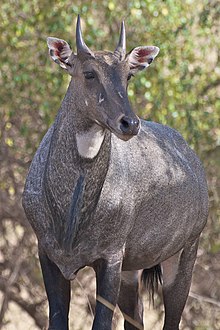
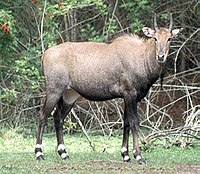


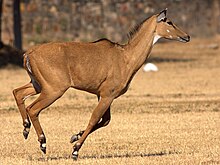


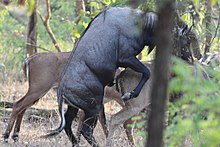
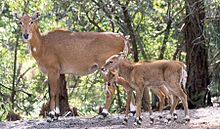
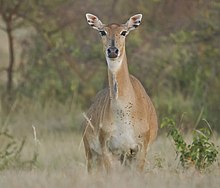


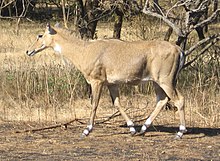


No comments:
Post a Comment
Note: Only a member of this blog may post a comment.